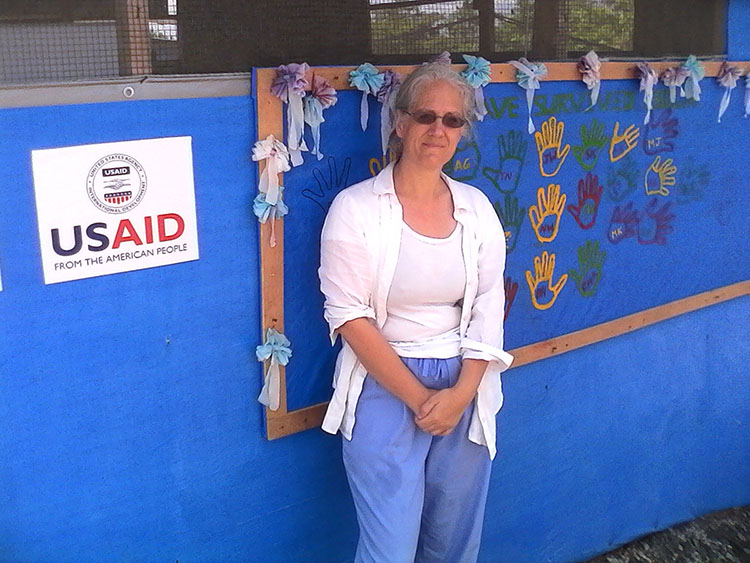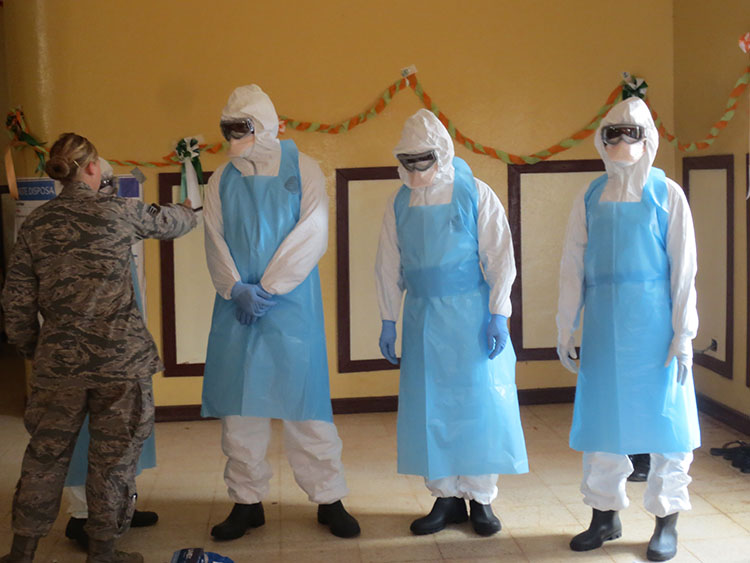
Elizabeth Glaser at an Ebola Treatment Unit in Bong County, Liberia
On March 20 and 21, the MS in International Health Policy and Management program is offering the pro seminar, "Ebola, Health Systems and Development." The seminar will be taught by Elizabeth Glaser, MS'08, MA'11, and a PhD candidate in social policy, who recently returned from Liberia where she served as an Ebola Response Clinician for Partners in Health. For more information on the seminar, please contact Elizabeth at eglaser@brandeis.edu.
The following is an excerpt of an essay on Elizabeth's Liberia experience that will appear in the upcoming Spring issue of Heller Magazine.
In December 2013, an Ebola Virus Disease (EVD) outbreak began in Guinea, West Africa. Unlike previous outbreaks along the forests of the Congo Basin, Ebola had not burned out after a short time—instead widespread and intense transmission had persisted, spreading to three countries, with limited disease activity in at least six more.
Once the opportunity arose to serve in the Ebola response, I took it. Since August I had been the moderator for the Ebola response community at Global Health Delivery Online, answering questions and facilitating discussion between health practitioners and researchers in 77 countries. My years as an HIV care nurse would be put to good use, and the presence of volunteers from prominent NGOs would likely bring much needed supplies and funding into the Ebola-afflicted countries of Guinea, Sierra Leone, and Liberia.
After a week of Infection Prevention and Control (IPC) training from the U.S. Centers for Disease Control and Prevention, I deployed to Liberia, receiving “hot training” in an Ebola Treatment Unit (ETU) in Bong County. The media and public seem to have had a genuine fascination with the ETU. Perhaps the reason for this is the perception of risk rightly associated with providing Ebola care, or our other-earthly appearance when in Personal Protective Equipment (PPE). I wrote in depth about my real time experiences in the ETU for the Partners In Health (PIH) blog but will briefly recount aspects of that experience here.

IPC training with the U.S. Department of Defense team in Zwedru, Grand Gedeh County, Liberia
During my time in the 25-bed unit, I cared for about 30 men, women, and children with Ebola. Despite the use of IV fluids and other interventions, the mortality rate at that ETU ranged between 50 to 60 percent. That’s a great improvement from the overall rate of 70 percent for the entire outbreak, but still unacceptable when we consider that mortality for Westerners at that time was a considerably lower 10 to 20 percent.
Electrolyte replacement, whether through oral intake or IV therapy, is an important key in increasing survival; however, there is insufficient data to accurately assess what interventions work best given comorbid conditions, viral mutations, and time from onset of symptoms to care. And we have no idea about the cost-effectiveness of interventions, which could be very useful in planning for future outbreaks. Our interventions helped some, as a few that appeared near death gradually pulled through, getting a little stronger every day. But death was still the more likely outcome for our patients. During a two-day period, we lost five people. The burial teams laid the dead in a cemetery located in a grove of trees at the bottom of the hill. The cemetery was quiet and peaceful, and far too full.
